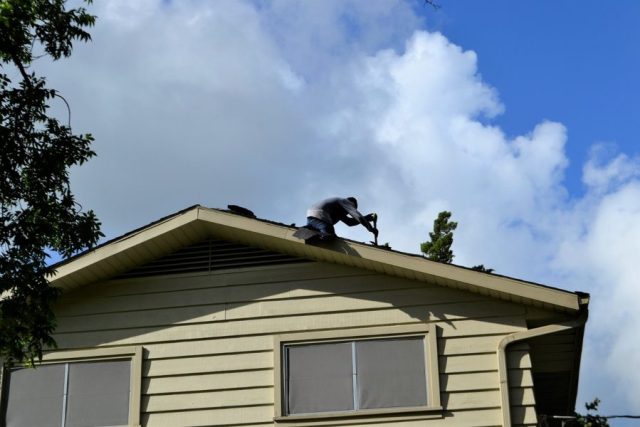Your home’s roof is one of its most vital components, protecting from the elements and keeping your family safe and dry. However, roofs are not immune to wear and tear, and problems can develop over time. Roofing issues, if left unchecked, can lead to significant damage and costly repairs. To avoid these headaches, it’s essential to spot roofing problems early and address them promptly. This comprehensive guide walks you through the critical signs to look for and the steps you can take to spot roofing problems before they escalate into major disasters.
Perform Regular Visual Inspections
The first step in spotting roofing problems is to conduct regular visual inspections. You don’t need to climb onto the roof for this; instead, use binoculars to get a closer look. Check for any missing, cracked, curled, or otherwise damaged shingles. These can expose your roof to water infiltration. You can get more information from www.helmuthroofing.com/ about roof inspections involving missing or damaged shingles. Inspect the shingles for any signs of buckling or warping. This can be an indication of moisture damage beneath the surface. Also, examine the metal flashing around chimneys, vents, and skylights. Look for any areas of the roof that appear to be sagging. This can indicate structural issues that require immediate attention.
While regular visual inspections can help you identify some roofing problems, having a professional roofing inspection every few years is wise. Roofing experts have the knowledge to detect subtle issues that may not be visible to the untrained eye. Furthermore, professional roofing inspections often involve advanced tools and techniques, such as thermal imaging, to uncover hidden problems like moisture infiltration. Investing in these periodic inspections can provide you with a comprehensive assessment of your roof’s condition, helping you plan for preventive maintenance, ultimately extending the lifespan of your roofing system and preserving the value of your home.
Check Your Attic
Your attic can provide valuable insights into the condition of your roof. On a sunny day, turn off the lights and look for any daylight coming through the roof boards. This is a clear sign of roof damage. Additionally, check for the following symptoms of trouble:
- Water Stains: Look for water stains or discoloration on the ceiling and walls of your attic. These indicate leaks in the roof.
- Mold and Mildew: Moisture infiltration can lead to mold and mildew growth. If you notice any, it’s a sign that your roof is not effectively preventing water from entering.
- Inadequate Ventilation: Poor attic ventilation can lead to heat and moisture buildup, damaging your roof and shingles. Make sure your attic has proper ventilation.
Inspect Your Gutters
Your gutters are crucial in diverting water away from your roof and foundation. Leaves, debris, and bird nests can clog your gutters, preventing water from flowing freely. Clean your gutters regularly to avoid water buildup. If your gutters are sagging or pulling away from the roofline, it can indicate problems with the gutter system or the roof structure itself. Check for any cracks or holes in your gutters. These can allow water to leak onto your roof or the sides of your home. Regular gutter maintenance is essential to prevent water-related roofing problems. When water cannot flow freely through your gutters due to clogs or sagging, it can pool water, potentially causing leaks and structural damage. Addressing these gutter issues can help maintain the integrity of your roofing system and prevent costly repairs down the line.
Watch For Ceiling Stains And Leaks
Inside your home, look for signs of ceiling stains or water leaks. These can indicate roofing problems that need immediate attention. Pay attention to damp spots or discoloration on your ceiling and walls, especially after heavy rain. Ceiling stains and water leaks often indicate underlying roofing issues that may have already progressed. Promptly addressing these interior signs of damage is crucial to prevent further harm to your home’s interior and the roofing system.
Monitor For Ice Dams
Ice dams can be a common roofing problem in areas with cold winters. Ice dams occur when melted snow refreezes at the roof’s edge, causing water to back up and potentially infiltrate your home. Look for signs of ice dams, such as icicles hanging from the eaves and water stains on your ceiling. Preventing ice dams is crucial, as they can lead to water damage and structural issues. Adequate insulation and ventilation in your attic can help regulate the temperature on your roof, reducing the risk of ice dam formation. Regularly inspecting your roof during winter and taking proactive measures to remove ice dams can safeguard your home from potential winter-related roofing problems.
Check For Critter Damage
Pests like raccoons, squirrels, and birds can cause damage to your roof. Look for signs of animal activity, such as chewed shingles, nests, or droppings. Addressing these issues can prevent further damage. Critter damage can compromise the integrity of your roofing system and create access points for pests into your home. If you notice any signs of animal activities, it’s essential to repair the damage and take steps to deter future intrusions. Timely action will not only protect your roof but also ensure the safety and comfort of your home.
Assess The Age Of Your Roof
The age of your roof can be a significant factor in its condition. Most roofs have a lifespan of 20-30 years. If your roof is nearing the end of its expected lifespan, it’s essential to be extra vigilant for signs of wear and tear. When your roof approaches the end of its expected lifespan, it becomes more susceptible to various issues, including leaks and shingle deterioration. Regular inspections and proactive maintenance become even more critical in extending its functional life and avoiding the inconvenience of premature replacement.
Spotting roofing problems before they escalate into significant issues is crucial for maintaining the integrity of your home and avoiding costly repairs. Regular visual inspections, monitoring for signs of damage, and addressing issues are vital to preserving the longevity of your roof. Remember that even minor issues can lead to significant damage if left unattended. If you’re ever in doubt about the condition of your roof, feel free to seek professional guidance from a trusted roofing contractor. Early detection and timely repairs are your best allies in keeping your roof in shape.














